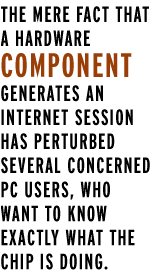| |||||||||

The row over a chip that "surfed" the Net
 Millions of personal computers have been sold to consumers with a chip that automatically connects to the Internet, and a variety of conspiracy theories are circulating on the Web as a result. Millions of personal computers have been sold to consumers with a chip that automatically connects to the Internet, and a variety of conspiracy theories are circulating on the Web as a result. The chip is Phoenix Technologies' AwardBIOS, a widely used component that most PC users never see except during the memory test the device runs during start-up. Oddly enough, Phoenix, which sells more than 100 million BIOS chips every year to makers of PC motherboards, started phasing out its limited-edition "PhoenixNet" version of the chip a few months ago. But the mere fact that a hardware component generates an Internet session has perturbed several concerned PC users, who want to know exactly what the chip is doing. When a PC running Windows 98 or Windows Me is started for the first time, a "PhoenixNet-enabled" machine takes the following steps, depending on its programming by Phoenix's business partners: • It launches a new application. The BIOS chip launches a program called the Permission Application. This application displays a dialog box saying, "Your new computer needs many basic tools which are essential to your use of the Internet." The message describes these tools as "online retailers, investment and financial help, communication tools, Internet radio," and others. • It sends a reject message. If the user clicks "Cancel," the Permission Application may send a reject message to a PhoenixNet Web server. The application also places an icon on the Windows desktop that can be used to run the procedure later. • It downloads client software. On the other hand, if the user clicks "Join," the application contacts the PhoenixNet server and downloads software called PhoenixNet Client. This client software then sends back to the server information about the PC's installed memory, operating system version, disk devices, and other technical data.
• It customizes the browser. The client software changes the home page and default search engine in the user's Internet Explorer browser and adds links to the browser's Favorites menu. Finally, several program icons for various services are installed on the Windows desktop. So far, these steps add up to little more than routine cross-marketing to a captive Windows audience. But the somewhat mysterious operation of PhoenixNet has raised suspicions. Many consumers question the right of software sellers to use a PC's Internet connection for any purposes they wish. Tim Gipson, business manager of Cexx.org, a site that critiques Internet security, describes as "particularly unnerving" the ability of PhoenixNet to install software before people are fully aware of what they're getting. Phoenix's customized BIOS chip shipped to motherboard makers as early as February 2000. But something several weeks ago sparked a stream of speculation on discussion groups. One Web page carried a list of 20 motherboard makers it said could have shipped PhoenixNet on "more than 40 million boards in the year 2000 alone." The real story, according to Rod Archer, senior director of operations and engineering for PhoenixNet, is that the sponsor-based program was canceled earlier this year as a business flop. "The financial model of the Internet fell apart," Archer explained in an interview. "We couldn't get enough interest." Archer says PhoenixNet was implemented in only 3 million PCs worldwide in 2000. Although more than 20 companies had at one point or another signed a letter of interest, Archer says, the only motherboard makers who wound up enabling PhoenixNet were six manufacturers: ACorp, EPoX, Iwill, Gigabyte, Jetway, Redfox, Soltek and Soyo. Even so, Archer says, "There might be one or two that may still be shipping it." And because inventory takes time to turn over, thousands of fully assembled PCs are sitting on shelves awaiting buyers who will turn PhoenixNet on for the first time. For those who are concerned, there's a simple remedy: Use the Add/Remove Software control panel in Windows to delete PhoenixNet Client from the machine. That stops it for good. Brian Livingston's Wired Watchdog column appears at CNET News.com every Friday. Do you know of a problem affecting consumers? Send info to tips@BrianLivingston.com. He'll send you a book of high-tech secrets free if you're the first to submit a tip he prints. about the writer |
|
|||||||||||||||||||||||
|
Send us news tips | Contact Us | Corrections | Privacy Policy |
|

